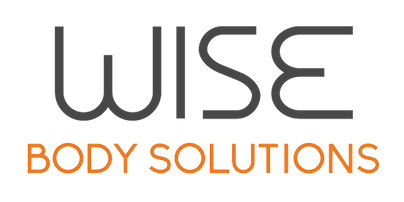The workout that improves other workouts
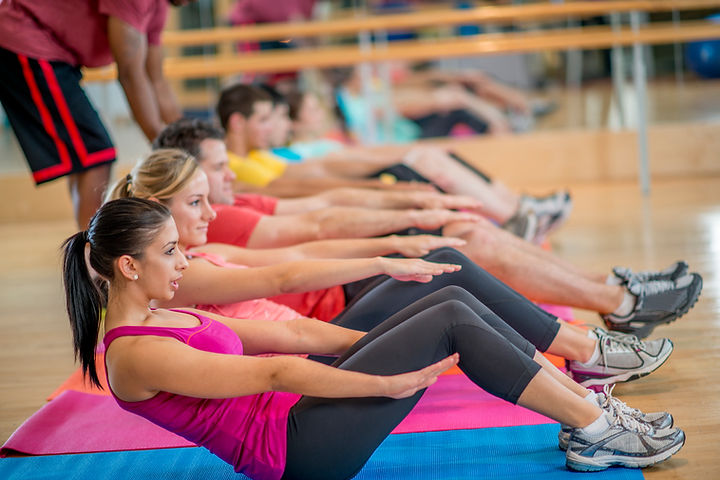
Pilates might sound intimidating but its unique approach does more than sculpt your muscles — it helps prevent injuries and improves other exercise efforts.
This method isn’t just for fitness fanatics and dancers, though these groups flocked to it first, pilates was first designed for those rehabilitating from injuries.
Explore how this remarkable method can aid everyone, from beginners to athletes, and learn my eight tips on how to get the most out of this discipline.
What is Pilates
The Pilates method, created by Joseph Pilates, was first developed during World War Ⅰ to help bedridden patients to exercise against resistance.
Originally called Contrology, Pilates combines a series of low-impact movements that improve flexibility, strength, and muscular control. Benefits often include sculpted, lean muscles that are healthy, responsive, and adaptable.
Pilates provides such profound results that it’s used to help condition professional athletes and keep TV and movie stars in shape.
Pilates is so versatile that it’s used in rehabilitation facilities due to its unique emphasis on breath, sensation, and slow controlled movements which are proven to help ease pain, improve ability and mobility.
Pilates accomplishes such dramatic results by stressing proper posture, body awareness, flexibility, and core strength. These attributes help you to perform your best, feel strong, and can even help to ease pain while reducing your risk of injury.
Perfect for everyBODY
The name is intimidating. So are the stereotypes that are associated with it. Then there’s the equipment.
But there’s a reason pilates is associated with dancers, athletes and fitness gurus. The effects are nothing short of amazing. Both beginners and exercise veterans can benefit from Pilates.
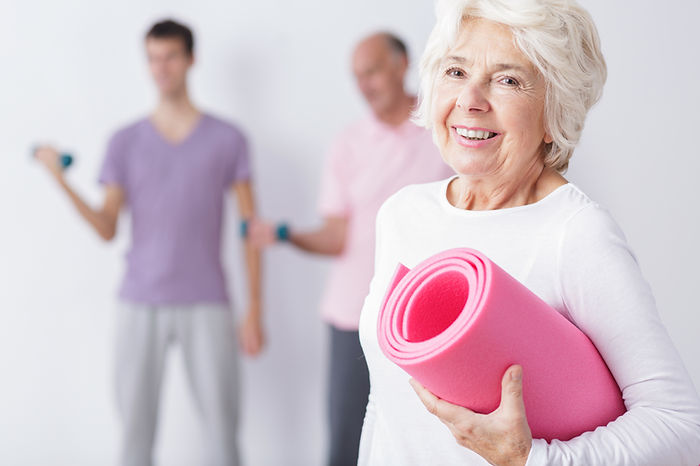
For beginners, young and old:
It’s a common misconception that you need to be in shape before you start practicing pilates.
(Hey, round is a shape, right?)
But really, Pilates is the perfect workout for beginners.
Every single movement teaches foundational stability and can be modified if it’s causing pain/discomfort.
Plus, many Pilates exercises can be practiced anywhere, any time, because they’re performed bodyweight on a mat.
And BONUS! Pilates doesn’t just teach you moves, Pilates optimizes how you use your body, a lesson that will apply to every other workout.
Pilates will teach you how to exercise. It provides a foundation for all other exercises.
Ready to try it out?
Not an exercise beginner? Pilates will make your other workouts better.
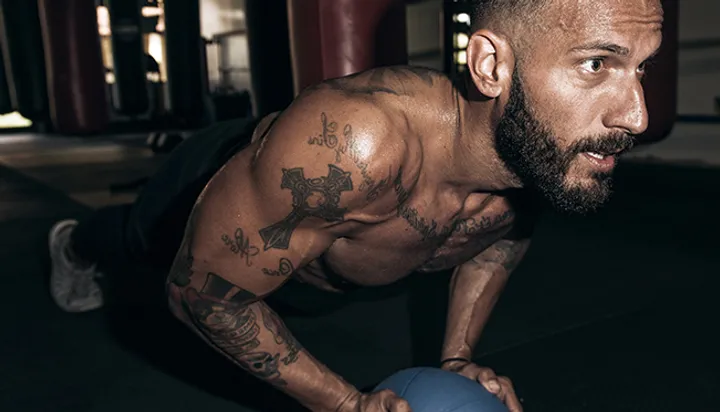
Pilates focuses on body awareness, balanced muscle development, and control from the center.
This unique way of focusing on exercise is 100% functional. It improves coordination, muscle memory, and improves posture- not just while you’re practicing but for every activity in and out of the gym. Best yet, these methods have been shown to reduce your risk of injury.
Pilates uses some common gym exercises, like planks, to challenge your core but adds elements of instability to improve your reactions and muscle use. Mindfulness has many proven benefits and when combine with exercise as a dramatic potent effect. The movements in Pilates are much slower than most weighted exercises in the gym, emphasizing precision over reps. This combination helps grow your brain as much as your muscles.
This method grows as you get stronger. All movements have varying levels of intensity and can be modified for either rehabilitation or for a challenge.
The benefits of Pilates are so profound that major football leagues have pilates equipment and instructors on-site.
So profound that it’s used in hospitals for children’s rehabilitation programs.
Pilates will transform everybody that practices.
Before your first class
Trying out a new gym or exercise method can be unnerving, but most clients tell me pilates is particularly intimidating. Just remember, everyone starts as a beginner. Heres some information you’ll want to know before heading to your first class.
First, pilates is offered at boutique pilates studios, larger fitness centers like YMCA, and small private-in home studios, as well as online.
If you’re just starting out with Pilates you’ll want some in-person instruction before trying out online classes. Online classes are great for learning new skills or trying out a different teacher but instructor correction is invaluable. Pilates lessons emphasize proper posture and form which can be hard to correct when practicing on your own.
In almost all physical locations, you can take private lessons or group classes. Private lessons are great for nervous beginners, students honing in on a certain technique or movement, or for peoples rehabilitating an injury. Some studios require a private lesson before you can enter a class. Groups classes (should be) limited to a small number to ensure that all participants get individualized instruction and help. In a group setting put yourself in the middle of the room and be sure to let the instructor know this is your first time. Being in the middle will allow the instructor to keep an eye on your form while you can watch others if you get lost.
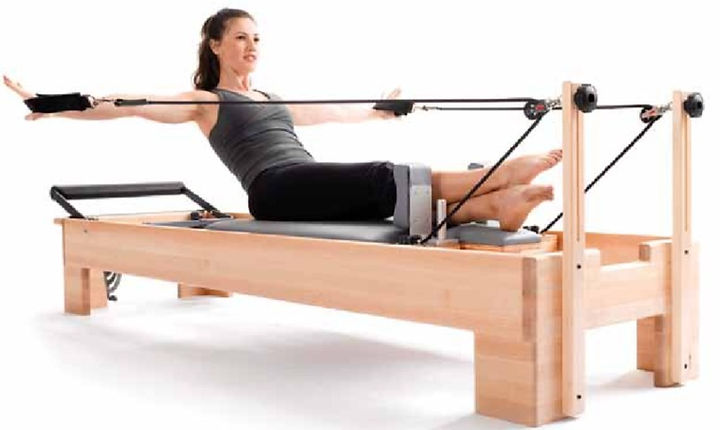
Reformers were originally designed using bed springs to aid patients rehabilitating exercise against resistance
Pilates can be practiced on equipment or on the floor (mat). There are many pieces of specialized Pilates equipment but the most common is a reformer. A reformer is a machine with a sliding platform attached to a frame with springs and pulleys. Once over the intimidation, clients report that the reformer is the most fun they’ve had in a workout. The pulley resisting the sliding platform makes it feel like you’re flying. Mat instruction includes bodyweight exercises in various positions to improve full-body strength and control.
Now that you’re ready for your first class, let’s set you up for success. (Or click here to schedule yourself!)
8 tips for success
Starting a Pilates exercise program might mean changing your thoughts about exercise. If you’re used to pushing yourself without listening to your body, these eight ideas will help you reframe how you approach lessons.
- BREATHE. Sounds simple, right? Holding your breath is the most common mistake I see beginners make. Beyond staying alive, breathing is central to using your core properly. I could dive into an explanation about that but let’s save that for another day. For now, just focus on even controlled breathing. If you can’t do that, scale back your intensity. It seems counter-intuitive, but I promise it’s worth it.
- Your core. It’s not just your abdominals, it’s your center, the place everything else attaches too. Every Pilates move will focus on accessing your base before layering on other movements. This might mean using a smaller range of motion with secondary layered movements to first train stability in the core.
- Consistent themes. Your instructor doesn’t lack creativity, there’s just a basic set of foundational movements necessary for every body. No fancy or complicated choreography necessary, these basics provide profound benefits all on their own. Practicing these moves will aid every lift, push and squat you ever do.
- Quality, not quantity. 10 perfect reps are far more beneficial than 30 reps with sloppy form. Focusing on quality saves you from practicing bad habits. You’re building a foundation, if you rush building your foundation you will surely have some inadequacies that will be hard to fix later.
- Focus on sensation. Sensation communicates with portions of our brain that control tension levels and joint position. Focusing on sensation will reduce your risk of injury while improving coordination.
- Slow down. It’s impossible to focus on sensation when you’re moving too fast. Moving slow and deliberate will increase your muscle’s endurance and improve your ability to focus on sensation, thus reducing your risk of injury.
- No pain, No gain is a NO GO. There is a big difference between difficult and painful. Contrary to popular opinion your muscles burning during a workout and hurting for days after isn’t necessary for the workout to be effective. Soreness after your sweat session is an indication of muscle damage, not workout success.
- It supplements other workouts. Pilates provides a ton of benefits but it doesn’t provide an aerobic workout so you’ll need an additional plan for getting that heart rate up.
Conclusion
Pilates was designed for everybody. Big, tall, strong and in need of help, pilates can help you reach both you fitness and mobility goals. Whether your practice on a mat in your house or on a reformer in a studio, the benefits of Pilates will extend beyond your workouts. Pilates is a time-proven exercise method that not only gains you killer abs, but it also decreases your risk of injury and improves your flexibility. Using basic movements Pilates can successfully help you transform how well you move, challenging your expectations of exercise.
Are you ready to try Pilates?
